This is a Keystone K1020 SLR, a single lens reflex camera sold by Keystone Camera Company, Inc, of Boston, Massachusetts starting in 1966. Although branded and sold by an American company, the camera was made in Japan, most likely by Mamiya. The K1020 uses Kodak’s Instamatic type 126 instant-load cassettes and takes either twelve or twenty 28mm x 28mm images per cassette. The K1020 was a rather advanced camera for it’s day and was the first Instamatic camera capable of automatic exposure. With a two speed shutter and fully adjustable diaphragm, the K1020 could automatically expose images in both natural light and when using the optional flash cube connector. The Keystone K1020 shares some similarities with other Mamiya built cameras, so its possible that parts or all of the camera were built in Japan by them, but this is still disputed.
Film Type: Kodak Instamatic Type 126 Cassettes
Lens: 48mm f/2.8 Super Keytar coated unknown elements
Focus: 3 feet / 0.9 meters to Infinity with Click Stop at Zone Focus Mark Near 10 feet
Viewfinder: Fixed SLR Pentaprism
Shutter: Metal “Trap” Shutter, Reflex Mirror Acts as Shutter
Speeds: Single Speed, ~1/125, Shutter Speed Drops to ~1/60 with Flash Cube Inserted
Exposure Meter: Coupled Selenium Cell w/ Viewfinder Readout and Programmed AE
Battery: (2x) Type N Batteries (For Flash Only)
Flash Mount: Rotating Flash Cube Electronic Flash
Other Features: None
Weight: 602 grams
Manual: https://www.cameramanuals.org/pdf_files/keystone_k-1020_slr.pdf
How these ratings work |
The Keystone K1020 was the first Instamatic SLR and was likely produced by Mamiya. It was a fully automatic camera that when found in good working condition is capable of really nice images. This was one of the better Instamatic cameras I’ve tried and one that I likely would use more often if good film was easier to come by. If you have some good Instamatic film you are dying to use, you could do a lot worse than this! | ||||||
| Images | Handling | Features | Viewfinder | Feel & Beauty | History | Age | |
| 2 | 1 | 1 | 1 | 1 | 1 | 20% | |
| Bonus | None | ||||||
| Final Score | 8.4 | ||||||
History
The brand Keystone rarely elicits excitement among camera collectors and users as they weren’t well known for it’s still camera output, but the company did play a much larger role than most collectors probably realize. The Keystone Camera Company was a division of the Keystone Manufacturing Company, an American company based out of Boston, Massachusetts whose roots go all the way back to the late 19th century, making all sorts of equipment for the photography industry.
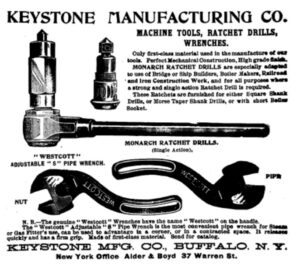
Keystone Manufacturing had factories in Buffalo and New York and made a large number of tools, dies, and other machinery for the manufacturing industry.
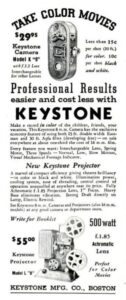
It is not clear who and when the company exactly started, or why they eventually entered the photographic industry. Camera-wiki and Wikipedia both have conflicting dates of 1910 and 1919 for the start of the company but I’ve found absolutely no evidence of the company’s activity in photography that early.
While scouring old magazines through Google Books, I was able to find a number of mentions for Keystone 8mm motion picture cameras like the model K8 camera in issues of LIFE Magazine as far back as 1937, but nothing before. It would seem that Keystone’s motion picture cameras were their bread and butter both before and after the war. American retailers like Willoughby’s in New York and Central Camera in Chicago sold Keystone cameras.
In the 1950s, Keystone produced a large number of slide projectors at various different price points. I couldn’t find much in the way of history for the company at this time, but I suppose at some point, the company decided that if they could make their own still cameras, and they could make slide projectors to project still images on a screen, why not get into the world of making still cameras.
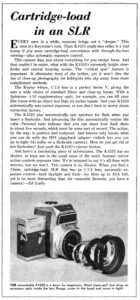
Once again camera-wiki and Wikipedia disagree on the exact year, but either in 1966 or 1968, the company was acquired by Berkey Photo. If the year was 1966, this would coincide with the release of the company’s first SLR, a fully automatic single lens reflex that used Kodak’s Instamatic “Instant load” cassette.
At the time of it’s release, it was the first Instamatic SLR, beating out both the Kodak Instamatic Reflex and Rolleiflex SL26 by two years. Featuring an “electric eye” with the ability of automatic exposure further added to the wow factor, bringing advance features such as AE and TTL viewing to what was widely considered an amateur film format.
In the short article to the left from the April 1967 issue of Camera 35 magazine, the Keystone K1020 is referred to as both a “real honey” and a “sleeper”. The editor, Ed Scully, quickly goes through the camera’s merits, AE in a cartridge based format. He says the camera does almost everything for you except focus. An image at the bottom shows how Series V filters and lens attachments can be screwed onto the camera’s lens to further expand it’s capabilities.
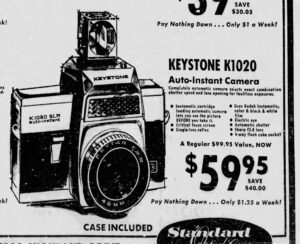
When the camera first went on sale, it was said to have a retail price of “under $100”, but the actual street prices were quite a bit lower, as evidenced by the $59.95 advertised price by Standard Optical in Salt Lake City, Utah from June 1968.
Apart from the short preview in April 1967 and a few newspaper ads for the camera, I found very little press about the camera. Nothing else appeared in any of the major US photography publications as those magazine’s target customers likely were disinterested in an Instamatic SLR.
I found evidence of the Keystone K1020 still being available in year end 1968 buyer’s guides but it is not clear how long after that the camera was still produced. Supporting a short life, both Kodak’s German built Instamatic Reflex and Rollei’s Rolleiflex SL26 had comparatively short lifes as well, suggesting the world wasn’t smitten by Instamatic SLRs.
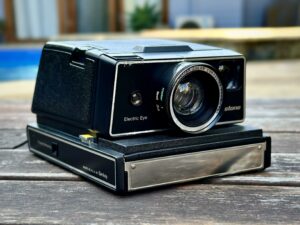
Keystone would continue to produce cameras, however they were of the extreme low end of the spectrum. With it’s ownership under Berkey Photo, Inc.’s control, the company as turned into little more than an OEM reseller of cheap Japanese and Chinese made cameras. A huge number of basic 126, 110, and 35mm cameras were released to little fanfare. The only other noteworthy cameras to ever bear the Keystone name were the ill fated Keystone Wizard XF 1000 and XF 1500, two of the only cameras to ever use Polaroid’s SX-70 film, but were not made by Polaroid themselves. The cameras were produced using technology without Polaroid’s permission, which resulted in a lawsuit and having to cease offering the camera.
The Keystone Camera Company would linger around in discount camera shop and back of magazine third party reseller ads until January 1991, when the company would file for Chapter 11 bankruptcy. Shortly thereafter, Keystone’s assets would be acquired by another camera reseller, the Concord Camera Company whose sold business was cheap novelty and disposable cameras. The original Keystone Manufacturing Company still exists, at least in some form, as their current website lists a line of conveyer belt, sprocket, and other industrial products.
Today, it is unlikely that most people have heard of Keystone cameras. Despite their brief claim as the makers of the world’s only Instamatic SLR, the company’s still cameras barely made a splash. More well known for their huge number of cheap bargain bin cameras, this simply isn’t a brand that too many people would go out of their way to add to their collection. Still, the Keystone K1020 is a recently built camera with a good interface, good lens, and is capable of making decent images on 126 film, so if you’re curious enough to give one a go, go for it, just don’t pay too much for one!
My Thoughts
The number of auto exposure SLR cameras that used Kodak’s Instamatic film was very small, but it wasn’t zero. When it was first released, Instamatic, or type 126 film, was envisioned as a simpler way to load film, eliminating the hassle of threading take up spools, or having to rewind film at the end of a roll. Simply pop in a cassette and close the door, and at the end, just open the door and take out the cassette.
At no point during the life of Instamatic film and cameras, was there ever a thought it would replace standard 35mm film used in every manner of professional and semi-professional camera, rather, it would accompany it on lower end cameras.
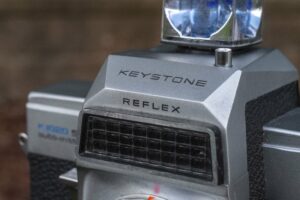
So in 1966 when the Keystone Camera Company released their new K1020 SLR, people were understandably excited. Here was a camera that offered the simplicity of auto exposure in an Instamatic SLR with a good f/2.8 lens, an extremely bright focusing screen, and supports electronic flash cubes in a mostly metal body with pretty good build quality, people were understandably excited.
The K1020 is an interesting camera, as it has the build quality and appearance of a fairly substantial Japanese camera produced, yet the name Keystone was more well known as a maker of cine cameras. Keystone’s still camera output was very small.
When I first handled the K1020, I was impressed with his heft. At 602 grams, the camera does not feel cheap. The chrome plating is as good as other mid level cameras by A-list companies like Minolta, Canon, or Olympus. The controls are logically laid out, and the ergonomics comfortable. With the simplicity of Instamatic film, you truly load in a new cassette and can immediately start shooting. You don’t even need a battery unless you plan on using the flash.
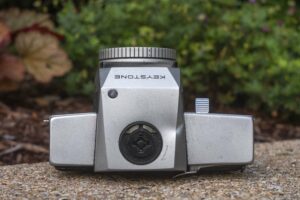
Up top, there’s little to see other than the circular Flashcube connection on top of the prism. For anyone whose never seen a Flashcube before, the name pretty much explains it as it’s literally a cube, with a separate single use flash on each of the four sides. The cube clicks into place in the socket simply by pressing it in with a moderate amount of force. As the photographer uses each flash, the cube automatically rotates in position to the next unused side. After using the cube four times, you eject it using a small chrome button near the front corner of the prism, and throw the cube away. Beyond that, there are no other controls, dials, buttons, or anything to see on the top plate of the camera.
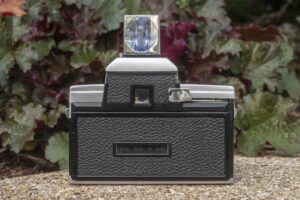
The back of the camera has the handle for the chrome plated film advance lever, and a rectangular window in the center of the door for reading the exposure information on the Instamatic. To keep costs low, when Kodak designed this film, the film itself was paper backed with printed exposure numbers on it, just like roll film. As the film is advanced, the exposure numbers could be read through a window in the cassette, which in turn could be read through a window in the back of each camera. This meant that Instamatic cameras never needed any sort of exposure counter. In addition to seeing the exposure numbers, the user could also read a label describing what kind of film was loaded.
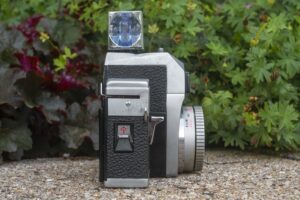
The sides and bottom are pretty barren, with only a 1/4″ tripod socket and flash battery compartment on the bottom, and door release on the right side. Both sides of the camera have front facing metal strap lugs which is a nice feature often missing from simple cameras.
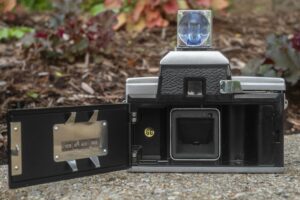
Loading film is truly as simple as drop and go. Open the left hinged door and insert the cassette and close the door. If you’ve never loaded an Instamatic camera before, make sure the label faces up because you cannot insert it upside down. Also, since the camera has an automatic eject mechanism when you open the door, a new cassette will not sit totally in place until after closing the door, so if it doesn’t feel all the way in, that’s ok, just hold it in place and close the door. Instamatic cassettes do have a paper leader in them to protect the film while it is out of the camera, so you’ll need to continually advance the film until you see the number 1 in the peep hole, at which point the camera should prevent you from continuing to advance.

Up front, the only things to see are the front body mounted shutter release and the focusing ring around the lens. The Keystone K1020 is a fully automatic camera, which means there is no way to manually control the diaphragm or shutter speeds. The focus ring is indicated in both feet and meters from 3 feet or 0.9 meters to infinity and a full rotation is right around 180 degrees. The lens itself is threaded to support Series V filters, and an accessory close up lens made by Spiratone was available for this camera as well.
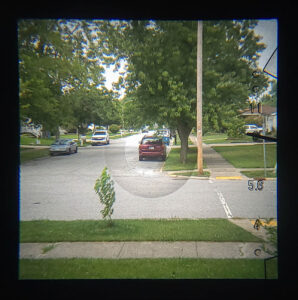
The viewfinder is bright when compared to other 35mm SLRs from the same era. All Instamatic film cameras expose 26mm x 26mm square images, so the viewfinder is square as well, which is a bit shocking the first time you look through one as non-medium format square SLRs were pretty uncommon. In the center of the focusing screen is a microprism dot with a ground glass circle around it. The rest of the focusing screen is also ground, but to a different texture than the ground glass circle. According to the limited information I could find about this camera, the ground glass circle around the microprism dot was to be used for critical focus.
The right side of the focusing screen has etched aperture f/stops. Although there are stops from 2.8 to 22, most are indicated with dots except 4, 5.6, 8, and 11. A needle moves up and down in accordance with the amount of light entering the selenium cell to indicate what f/stop the metering system will use. The K1020 has only two shutter speeds, 1/60 without flash, and 1/30 with a flash cube inserted. The metering system will compensate for both.
One last note about the K1020 is although it has a fixed lens, the lens itself accepts Series V filters and attachments, so with a close-up or telephoto attachment, the focal length of the lens can be changed, which when combined with the through the lens viewfinder, allow for interchangeable-lens-like SLR flexibility.
And that’s it, but before we continue onto the next section, I should point out that the greatest feature of the K1020 is the balance of advanced features using a film n format not primarily designed for advanced cameras, wrapped up in a high quality metal body that is extremely simple and easy to use. Whether you have never shot a film camera before, or are a seasoned pro, the Keystone K1020 can be used by anyone.
My Results
Anytime you use a camera that was created for an extinct film format, some compromises need to be made. For cameras designed for Kodak’s 620 film, the compromise is easy, just roll some fresh 120 onto 620 spools and you’re good to go. For 127, you can cut down fresh 120 to 127 size, or use one of the few new 127 films that are out there which are either taken from bulk 46mm stock, or some type of cinema film. For Instamatic 126 film however, no one currently makes fresh 126 film. The reason is likely because of the complexity of the mold for the cassette itself, not the actual film.
When it came time to shoot the Keystone K1020, I had a few choices. For my first attempt, I used the Fakmatic 126 reloadable cassette which emulates real Instamatic 126 film using bulk 35mm film. Compromises with this is that a row of perforations will be visible across part of the exposed image, but also that some cameras won’t advance the film correctly as 35mm film lacks the indicator present in real Instamatic film telling the camera to stop advancing. For this first roll, I loaded in some bulk Kodak Vision3 50D that I had laying around and took it out shooting.
Kodak Vision3 50D is a cinema film which comes with something called a Remjet layer which protects the film in cinema cameras, but must be removed in still photo cameras. I normally do this removal myself, but for reasons I cannot explain, on this roll, I did a pretty poor job of it, leaving artifacts all over the film. It wasn’t my best work. Furthermore, most of the images were shot in less than ideal lighting, giving the images a strong cyan shift. The images didn’t look back, but I thought I could do better.
For my second roll, I found some expired Kodak Gold 200 Instamatic film that expired in the 1990s. I have shot expired Kodak Gold before and gotten usable results from it, so I figured that using real Instamatic film in a real Instamatic cassette would yield serviceable results.
Nope. The base fog on that roll was so heavy, my scanner couldn’t pick up anything resembling a usable image.
For attempt number three, I turned to vintage film enthusiast Adam Paul, so had some bulk unperforated Kodak Imagelink Microfilm that he hand loaded into a real Instamatic cassette and using a hole puncher in a dark room, punched the correct perforations that real Instamatic film had. Not only would this method eliminate the visible perforations across the image, but the film advance should work correctly too. I loaded in this roll and optimistically thought, if I don’t get good results from this roll, then this review of the Keystone K1020 just wasn’t meant to be!
Finally! Something resembling true Instamatic film. For starters, the film showed heavy grain, and there were some light leaks, likely caused when Adam was loading the cassette and possibly even punching holes into the film, but the images are largely usable.
I was impressed with the accuracy of the meter on the camera, as the Keystone K1020 is an AE only camera, and there is no way to control exposure manually. Every shot from the ones taken in bright sunlight, heavy shade, and even my bathroom mirror selfie came out pretty close to properly exposed.
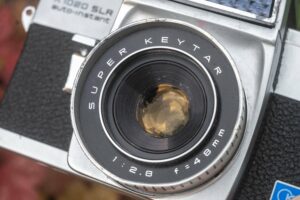
The Super Keytar lens renders some really nice looking and sharp images. Although the grain does somewhat diminish fine detail, it is clear that center sharpness is excellent with only minimal softness and no obvious vignetting near the corners. The jury is still out on whether or not this camera was made by Mamiya, but based on the high quality images that this lens produced, I am leaning more toward Mamiya than ever before, as they were one heck of a lensmaker as well.
One thing that I found interesting is that a common complaint of Instamatic film was in regards to film flatness. One of the drawbacks to the Instamatic cassette was that the film passed through the cassette with little to no pressure to make sure it was flat. This lack of flatness supposedly was the cause of many images from these type of cameras to come out blurry or soft. I didn’t notice any such softness in these images. That’s not to say that it couldn’t still happen, but I have to wonder if some cameras are better at keeping the film flat by maintaining tension on the film than others. Perhaps better cameras had a way to prevent the film from curling in the cassette. Who knows.
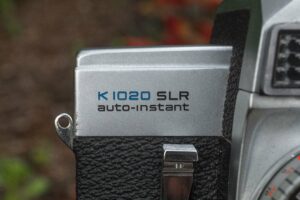
Shooting the Keystone K1020 was a joy. Despite a rather boxy looking body, the overall size and location of the camera’s controls is well laid out. The front body shutter release is in comfortably reach of my right index finger, and with only the need to focus the lens, I could keep my left hand supporting the camera while keeping my thumb and index finger cradling the focus ring.
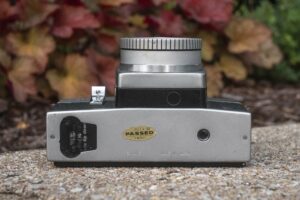
I was lucky to find an example of this camera that had a working meter, but with a dead one, the mechanical two-speed shutter would still work with the lens always wide open, so if you were to find one of these cameras with an inoperable meter, you could still try it in situations where an f/stop of 2.8 would work.
I could nitpick on a few things here and there, and after seeing these images, it was a struggle not to want to try again with a finer grain film, or perhaps something fresh loaded into the Fakmatic, but after 3 years of owning this camera and multiple rolls, I felt as though I learned all I needed to know about it. Besides, this was an entry level camera, targeted at the customer who wanted a fully automatic camera and didn’t want to be bothered with more fancy cameras. More than likely, original owners would have been happy with the feature set of a more professional style SLR, with Instamatic simplicity.
I was really impressed with the images I got from the Keystone even if all three rolls had issues. Of course none of those issues are the fault of the camera, more of the era in which I am using it. I won’t pretend to think that there’s many people out there ready and willing to jump through the hoops I did to shoot one of these cameras, but if you find yourself with an unusual supply of viable Instamatic 126 film, you could do a LOT worse than the Keystone K1020!
Related Posts You Might Enjoy
External Links
http://camera-wiki.org/wiki/Keystone_K_1020_SLR_Auto-Instant_Reflex
http://knippsen.blogspot.com/2015/08/keystone-k-1020-auto-instant-reflex.html
https://junkstorecameras.com/camerareviews/keystone-k1020-slr/
https://www.photrio.com/forum/threads/126-film-for-a-keystone-k-1020-slr-reflex.146484/

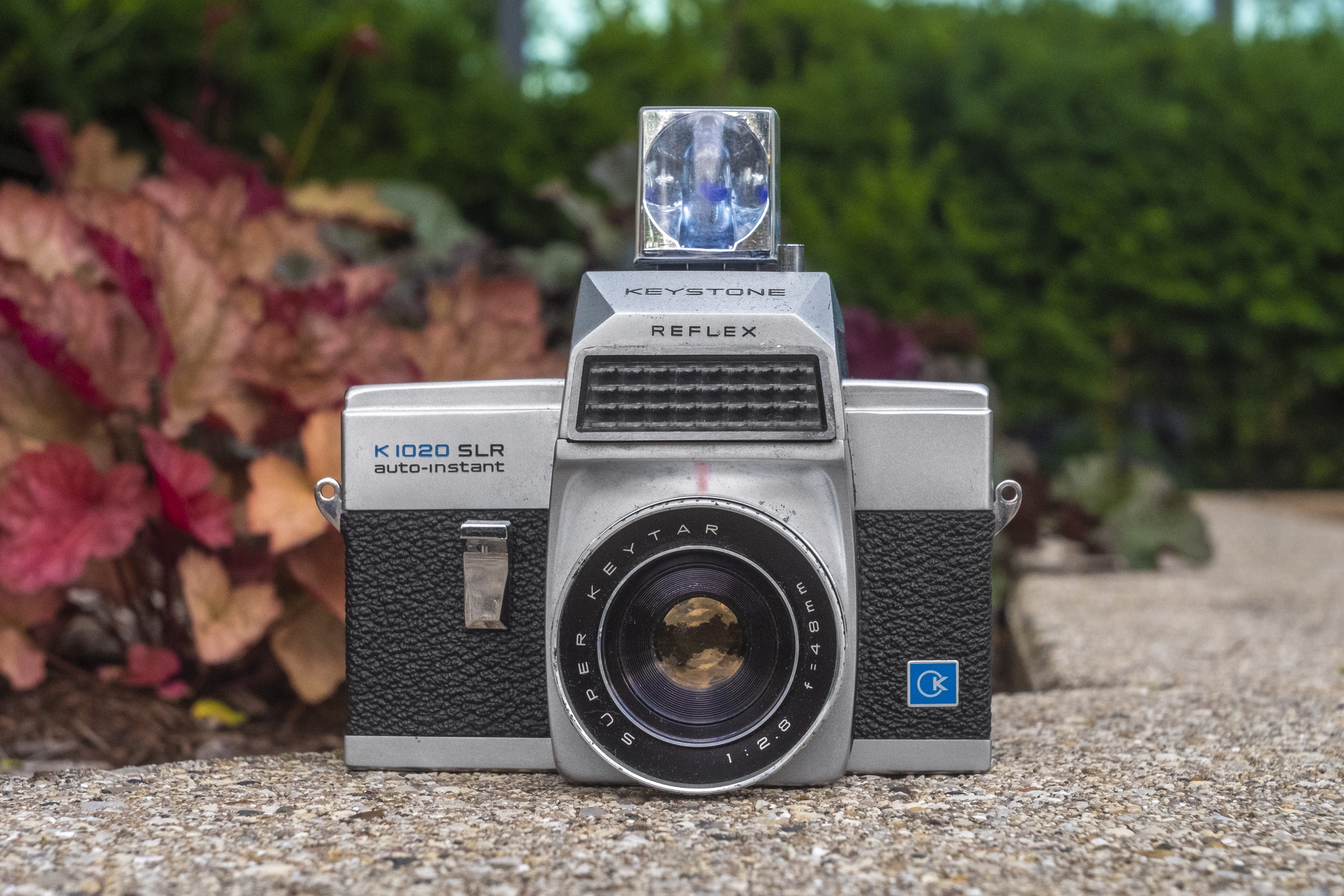
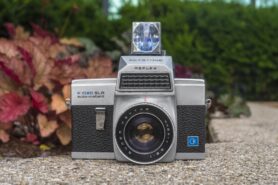
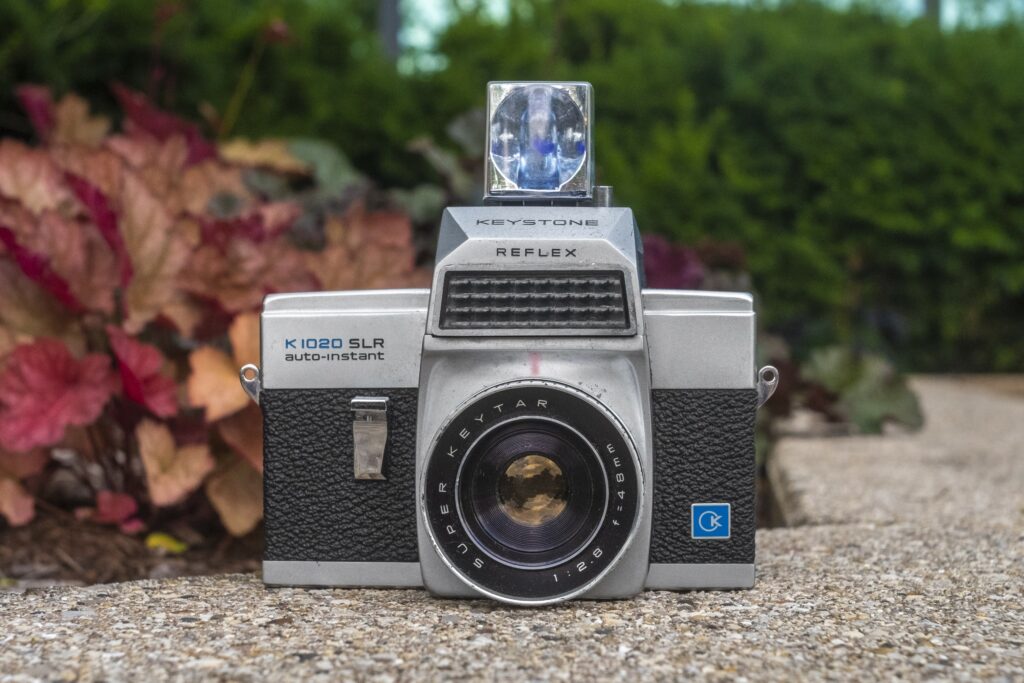



















Mike, A good copy of the instruction manual is to be found on Butkus.
Thanks Terrence, I always include a link to the manual on Butkus’s site when they exist. I find that it’s really helpful to read the manual each time I pick up another old camera! 🙂